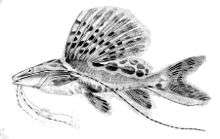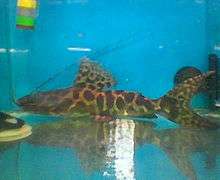Leiarius
Leiarius is a genus of long-whiskered catfishes native to South America. Most of the genus' species are found in the aquarium hobby as ornamental fish.
| Leiarius | |
|---|---|
 | |
| Leiarius pictus | |
| Scientific classification | |
| Kingdom: | Animalia |
| Phylum: | Chordata |
| Class: | Actinopterygii |
| Order: | Siluriformes |
| Family: | Pimelodidae |
| Genus: | Leiarius Bleeker, 1862 |
| Type species | |
| Arius? longibarbis Castelnau, 1855 | |
| Synonyms | |
Species
There are currently four recognized species in this genus:[1]
- Leiarius arekaima (Jardine, 1841)
- Leiarius longibarbis (Castelnau, 1855)
- Leiarius marmoratus (Gill, 1870) (Marbled catfish, Marbled pim)
- Leiarius pictus (Müller & Troschel, 1849) (Marbled sailfin catfish, Sailfin pim)
Anatomy and physiology

L. marmoratus can reach a little more than 100 centimetres (39 in) TL and has a maximum published weight of about 12 kilograms (26 lb).[2] L. pictus grows to 60 cm (24 in) TL.[3]
These two species can be easily confused. The body of L. pictus is brown with darker brown spots, with a paler ventral coloring. In juvenile L. pictus, two parallel, pale bands curve from the dorsal fin down the body towards the caudal fin.[4] In young fish of both species, the maxillary barbels are very long and ringed with black and white.[5] As both of these species grow, their barbels will shorten in proportion to their size, and the caudal fin lobes, which are rounded in the young, become much more pointed.[4][5] As L. marmoratus grows older, it darkens and its dark spots develop into a marbled pattern.[5] Both species have a large, sail-like dorsal fin.[4][5]
There are no external sexual differences.[4]
Range and distribution
L. marmoratus is found in the Amazon, Essequibo, and Orinoco River basins.[2] On the other hand, L. pictus is only found in the Amazon and Orinoco River basins.[3]
Ecology
L. marmoratus inhabits riverbeds, deep wells, and lakes. Young or sub-adults form large schools. This species prefers to lay over rock and tree trunks during the day, being more active at sunrise, sunset, and night.[2]
Importance to humans
In aquaria
Both L. marmoratus and L. pictus are ornamental fish kept as pets in the aquarium hobby.[6] They have a voracious appetite and can grow rapidly, and therefore should be kept in a very large aquarium. These fish are peaceful towards other large fish.[5] Some sort of retreat to allow these fish to hide during the day is required.[4][5] These fish get very large and are not recommended for the average aquarist.[4]
References
- Froese, Rainer and Pauly, Daniel, eds. (2012). Species of Leiarius in FishBase. February 2012 version.
- Froese, Rainer and Pauly, Daniel, eds. (2007). "Leiarius marmoratus" in FishBase. June 2007 version.
- Froese, Rainer and Pauly, Daniel, eds. (2007). "Leiarius pictus" in FishBase. June 2007 version.
- "PlanetCatfish::Catfish of the Month::April 2003". PlanetCatfish.com. 2007-01-24. Retrieved 2007-06-22.
- Axelrod, Herbert R.; Emmens, C.; Burgess, W.; Pronek, N. (1996). Exotic Tropical Fishes. T.F.H. Publications. ISBN 0-87666-543-1.
- Fenner, Robert. "Shovelnoses, Pictus, Tigers and More, The Antennae Catfishes, Family Pimelodidae". Retrieved 2007-06-22.
Bibliography
- Froese, Rainer and Pauly, Daniel, eds. (2009). Species of Leiarius in FishBase. January 2009 version.